首页 > 基础资料 博客日记
Java常用设计模式 23种设计模式全面解析(超级详细)
2023-08-09 17:02:20基础资料围观538次
Java常用设计模式 23种设计模式全面解析(超级详细)
一、设计模式概念
1、定义
Java包含23种设计模式,是一套对代码设计经验的总结,被人们反复利用,多人熟知的代码设计方式。
2、目的
为了提高代码的可读性,可扩展性以及代码的复用性,为了解决在写代码过程中遇到的代码设计问题。
3、设计模式的六大原则
3.1开闭原则
对扩展开放,对修改关闭(尽可能对代码少修改)
3.2里氏替换原则
它是面向对象基本原则之一,任何父类(基类)出现的地方,子类都可以出现,也就是子类可以替换父类的任何功能(体现了父类的可扩展性)
3.3依赖倒转原则
尽可能面向接口编程,依赖接口而不依赖类
3.4接口隔离原则
一个类如果能实现多个接口,尽可能实现多个,为了降低依赖,降低耦合
3.5最少知道原则
一个实体尽可能少的与其他实体产生相互关联关系,将实体的功能独立
3.6合成复用原则
尽量使用合成,聚合的方式,而不使用继承
4、设计模式的分类
Java设计模式分为三大类
创建型模式:对象实例化的模式,创建型模式用于解耦对象的实例化过程。
结构型模式:把类或对象结合在一起形成一个更大的结构。
行为型模式:类和对象如何交互,及划分责任和算法。
如下图所示:
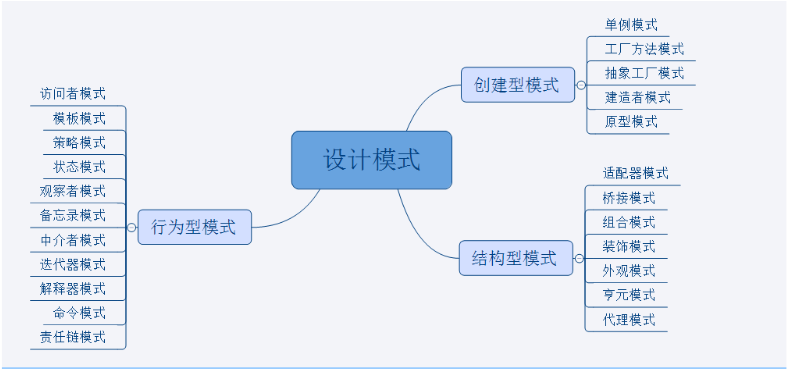
二、常用的几种设计模式
1、单例模式
单例模式是创建对象的一种特殊方式,程序从始至终都只创建一个对象叫单例(单实例)
分为两类
1.1、懒汉式单例
-
public class Person{
-
//为了不让其他类直接访问该成员 懒汉式单例,在使用时创建对象
-
//1、私有静态变量
-
private static Person person=null;
-
//2、将构造器私有化
-
private Person(){
-
-
}
-
//3、提供一个静态方法,并返回该类的对象
-
public static Person getInstance(){
-
if(person==null){
-
//第一次访问
-
person=new Person();;
-
}
-
return person;
-
}
-
public void sayHello(){
-
System.out.println("sayHello方法");
-
}
-
}
1.2、饿汉式单例
-
public class Student {
-
//1、 饿汉式单例模式, 在类加载时创建一个对象
-
private static Student student = new Student();
-
-
// 2 构造器私有化
-
private Student(){
-
-
}
-
// 3 提供返回类对象的静态方法
-
public static Student getInstance(){
-
if(student !=null){
-
return student;
-
}
-
return null;
-
}
-
}
2、工厂方法模式
创建对象的过程不再由当前类实例化,而是由工厂类完成,在工厂类中只需要告知对象类型即可。工厂模式中必须依赖接口
2.1简单工厂模式
简单工厂模式的工厂类一般是使用静态方法,通过接收的参数的不同来返回不同的对象实例。不修改代码的话,是无法扩展的。
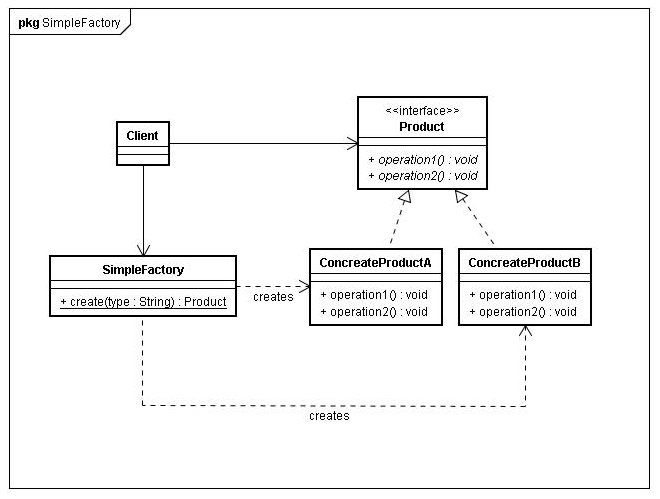
以生产“电脑”为例,电脑有办公的功能,可以生产一体机或笔记本
代码与静态工厂一样
2.2静态工厂模式
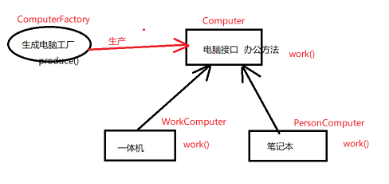
-
//电脑接口
-
public interface Computer {
-
//电脑办公
-
public void work();
-
}
-
//笔记本
-
public class PersonComputer implements Computer{
-
-
-
public void work() {
-
System.out.println("这是笔记本电脑,正在办公");
-
}
-
}
-
//一体机
-
public class WorkComputer implements Computer{
-
-
-
public void work() {
-
System.out.println("这是一体机正在办公");
-
}
-
}
-
//用于生产电脑的工厂 (这个工厂既可以生产台式机也可以生产笔记本)
-
public class ComputerFactory {
-
-
/**
-
* 根据不同的类型 生产不同的产品
-
* @param type
-
* @return
-
*/
-
public Computer produce(String type){
-
Computer computer =null;
-
if(type.equals("personComputer")){
-
computer = new PersonComputer();
-
}else if(type.equals("workComputer")){
-
computer = new WorkComputer();
-
}else{
-
System.out.println("不能生产");
-
}
-
return computer;
-
}
-
//静态工厂方法模式
-
public class ComputerFactory2 {
-
/**
-
* 静态工厂方法
-
* @param type
-
* @return
-
*/
-
public static Computer produce(String type){
-
// 定义一个接口的引用 通过接口new 一个实现类的对象
-
// 提高扩展性
-
Computer computer=null;
-
if(type.equals("workComputer")){
-
computer = new WorkComputer();
-
}else if(type.equals("personComputer")){
-
computer = new PersonComputer();
-
}else{
-
System.out.println("不能创建对象");
-
}
-
return computer;
-
}
-
}
-
//测试类
-
public class Test1 {
-
public static void main(String[] args) {
-
// 通过工厂类创建对象
-
ComputerFactory factory = new ComputerFactory();
-
// 要对象 找工厂
-
Computer computer1 = factory.produce("workComputer");
-
computer1.work();
-
// 创建笔记本
-
Computer computer2 = factory.produce("personComputer");
-
computer2.work();
-
-
Computer computer3 = ComputerFactory2.produce("workComputer");
-
computer3.work();
-
}
-
}
3.3工厂方法模式
工厂方法是针对每一种产品提供一个工厂类。通过不同的工厂实例来创建不同的产品实例。在同一等级结构中,支持增加任意产品。
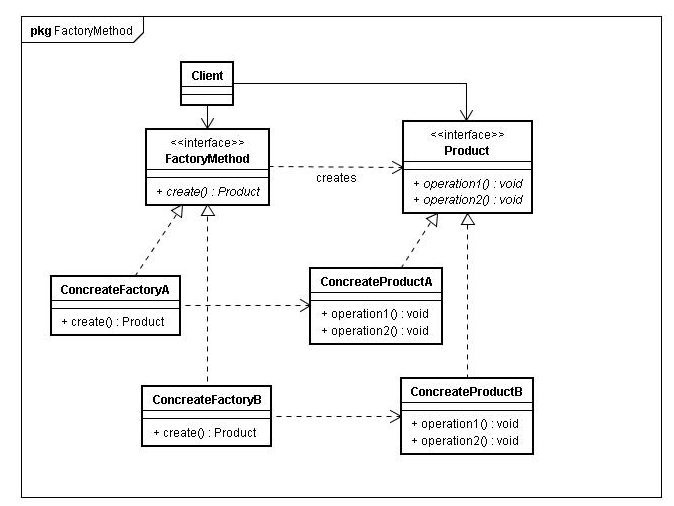
例如:
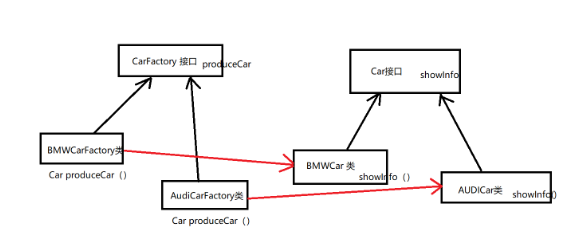
-
//汽车接口
-
public interface Car {
-
public void showInfo();
-
}
-
public class AudiCar implements Car {
-
-
public void showInfo() {
-
System.out.println("这是一台奥迪汽车。。");
-
}
-
}
-
public class BMWCar implements Car {
-
-
public void showInfo() {
-
System.out.println("这是一台宝马汽车。");
-
}
-
}
-
/**
-
生产汽车的工厂接口
-
**/
-
public interface CarFactory {
-
public Car produce();
-
}
-
public class AudiCarFactory implements CarFactory {
-
-
public Car produce() {
-
-
return new AudiCar();// 这里AudiCar是Car的实现类
-
}
-
}
-
public class BMWCarFactory implements CarFactory {
-
-
public Car produce() {
-
return new BMWCar();// 因为BWMCar是Car的实现类
-
}
-
}
-
-
public class Test1 {
-
public static void main(String[] args) {
-
//先创建 汽车工厂
-
CarFactory bmwFactory = new BMWCarFactory();
-
// 这个工厂生产的汽车就是 宝马
-
Car bmw = bmwFactory.produce();
-
bmw.showInfo();
-
-
//这个模式对于同一级别的产品,可扩展性高
-
//可以扩展不同品牌的汽车,此时不需要修改代码,只需要增加代码即可
-
// 创建一个新的品牌汽车 大众汽车
-
-
CarFactory dazhongFactory = new DazhongCarFactory();
-
Car car = dazhongFactory.produce();
-
car.showInfo();
-
}
-
}
-
3、抽象工厂模式
对于在工厂方法的基础上,对同一个品牌的产品有不同的分类,并对分类产品创建的过程 ,一个汽车产品 会分为不同的种类(迷你汽车 ,SUV汽车 )
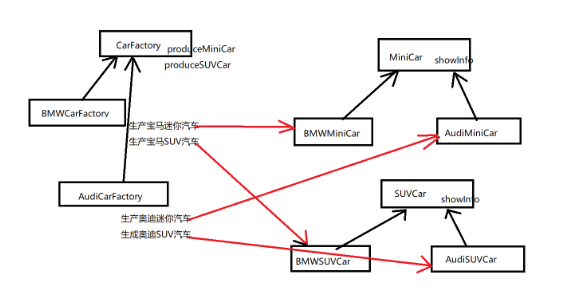
-
/**
-
* 迷你汽车接口
-
*/
-
public interface MiniCar {
-
public void showInfo();
-
}
-
/**
-
* SUV汽车接口
-
*/
-
public interface SUVCar {
-
public void showInfo();
-
-
}
-
public class AudiMiniCar implements MiniCar {
-
-
public void showInfo() {
-
System.out.println("这是奥迪迷你汽车 ");
-
}
-
}
-
public class BMWMiniCar implements MiniCar {
-
-
public void showInfo() {
-
System.out.println("这是宝马Cooper迷你汽车");
-
}
-
}
-
public class AudiSUVCar implements SUVCar {
-
-
public void showInfo() {
-
System.out.println("这是一辆 奥迪SUV汽车");
-
}
-
}
-
public class BMWSUVCar implements SUVCar {
-
-
public void showInfo() {
-
System.out.println("这宝马的SUV系列");
-
}
-
}
-
public interface CarFactory {
-
//生成不同型号的汽车 ,两条产品线
-
public MiniCar produceMiniCar();
-
-
public SUVCar produceSUVCar();
-
}
-
public class AudiCarFactory implements CarFactory {
-
-
public MiniCar produceMiniCar() {
-
return new AudiMiniCar();
-
}
-
-
-
public SUVCar produceSUVCar() {
-
return new AudiSUVCar();
-
}
-
}
-
public class BMWCarFactory implements CarFactory {
-
// 生成迷你汽车的方法,返回MiniCar
-
-
public MiniCar produceMiniCar() {
-
return new BMWMiniCar();
-
}
-
//生成SUV汽车的方法, 返回SUVCar
-
-
public SUVCar produceSUVCar() {
-
return new BMWSUVCar();
-
}
-
}
-
/**
-
* 测试类
-
*/
-
public class Test1 {
-
public static void main(String[] args) {
-
//创建宝马迷你汽车 找工厂
-
CarFactory factory = new BMWCarFactory();
-
MiniCar car = factory.produceMiniCar();
-
car.showInfo();
-
}
-
}
总结:对于简单工厂,工厂方法模式和抽象工厂的区别和用途
小结:
★工厂模式中,重要的是工厂类,而不是产品类。产品类可以是多种形式,多层继承或者是单个类都是可以的。但要明确的,工厂模式的接口只会返回一种类型的实例,这是在设计产品类的时候需要注意的,最好是有父类或者共同实现的接口。
★使用工厂模式,返回的实例一定是工厂创建的,而不是从其他对象中获取的。
★工厂模式返回的实例可以不是新创建的,返回由工厂创建好的实例也是可以的。
区别:
1、对于简单工厂,用于生产同一结构中的任意产品,对于新增产品不适用。
2、对于工厂方法,在简单工厂的基础上,生产同一等级结构中笃定产品,可以支持新增产品。
3、抽象工厂,用于生产不同种类(品牌)的相同类型(迷你,SUV),对于新增品牌可以,不支持新增类型
8、模板方法
定义:
模板方法是一种行为模式,父类的一个方法定义完成这个方法的步骤,但不具体实现具体细节,由子类完成各个步骤的实现,在创建子类对象时,最终实现过程是子类的方法。
模板方法的准备:
1、继承关系
2、父类是抽象类:抽象类实现了模板方法,定义了算法的估计
3、子类继承抽象类:实现抽象方法,完成完整的算法
-
public abstract class AbstractPerson {
-
/**
-
* 定义一个模板方法,用于实现这个方法的基本“骨架”
-
* 每一步骤的具体实现由子类完成
-
*/
-
public void preparedSchool(){
-
getUp();
-
dressing();
-
eat();
-
}
-
//起床
-
public abstract void getUp();
-
//穿衣服
-
public abstract void dressing();
-
//吃早餐
-
public abstract void eat();
-
}
-
public class Student extends AbstractPerson {
-
-
public void getUp() {
-
System.out.println("学生起床,起不来,闹钟响3次");
-
}
-
-
-
public void dressing() {
-
System.out.println("学生穿衣服,找不到衣服");
-
-
}
-
-
-
public void eat() {
-
System.out.println("学生吃早餐,来不及吃早餐");
-
-
}
-
}
-
public class Teacher extends AbstractPerson {
-
-
public void getUp() {
-
System.out.println("老师起床,7点半起床");
-
}
-
-
-
public void dressing() {
-
System.out.println("老师要衣服得体,穿工装");
-
}
-
-
-
public void eat() {
-
System.out.println("老师吃早餐。");
-
}
-
}
-
public class Test1 {
-
public static void main(String[] args) {
-
Student stu = new Student();
-
stu.preparedSchool();
-
-
Teacher teacher = new Teacher();
-
teacher.preparedSchool();
-
-
}
-
}
原贴地址:点我跳转
本文来自互联网用户投稿,该文观点仅代表作者本人,不代表本站立场。本站仅提供信息存储空间服务,不拥有所有权,不承担相关法律责任。如若内容造成侵权/违法违规/事实不符,请联系邮箱:jacktools123@163.com进行投诉反馈,一经查实,立即删除!
标签:


